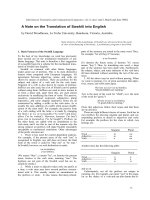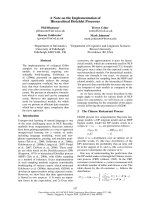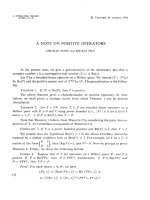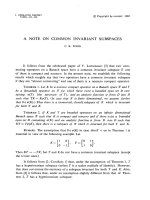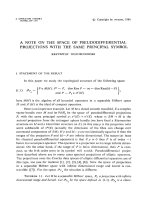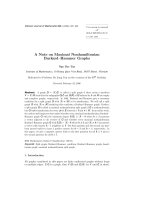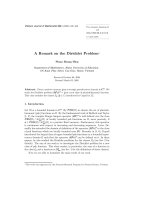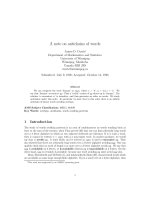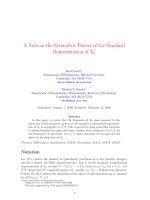Báo cáo toán học: "A note on the ranks of set-inclusion matrices" pps
Bạn đang xem bản rút gọn của tài liệu. Xem và tải ngay bản đầy đủ của tài liệu tại đây (43.91 KB, 2 trang )
A note on the ranks of set-inclusion matrices
D. de Caen
Department of Mathematics and Statistics
Queen’s University
Kingston, Ontario, Canada K7L 3N6
Submitted: June 11, 2001; Accepted: June 16, 2001
Abstract
A recurrence relation is derived for the rank (over most fields) of the set-inclusion
matrices on a finite ground set.
Given a finite set X of say v elements, let W = W
t,k
(v) be the (0,1)-matrix of inclusions
for t-subsets versus k-subsets of X : W
T,K
=1ifT is contained in K, and 0 otherwise.
These matrices play a significant part in several combinatorial investigations, see e.g. ([2],
Thm. 2.4).
Let F be any field, and let r
F
(M) denote the rank of M over F .
Theorem. If (k − t) =0inthefieldF ,then
r
F
(W
t,k
(v +1))=r
F
(W
t,k−1
(v)) + r
F
((k − t +1)W
t−1,k
(v)). (1)
Proof. The block-matrix identity
I −A
0 I
AB 0
BBC
I −C
0 I
=
0 −ABC
B 0
implies that, over any field F ,
r
F
AB 0
BBC
= r
F
(B)+r
F
(ABC). (2)
The set-inclusion matrix has the block-triangular decomposition
W
t,k
(v +1)=
W
t−1,k−1
(v)0
W
t,k−1
(v) W
t,k
(v)
, (3)
the electronic journal of combinatorics 8 (2001), #N5 1
as may be seen by fixing x in X and classifying t-sets and k-sets according to whether x
belongs to them or not. Further, there is the elementary product formula
W
t,k
(v)W
k,l
(v)=
l − t
k − t
W
t,l
(v)(4)
whose proof is left as a straightforward exercise. Using (4), one may re-write (3) as
W
tk
(v +1)=
1
(k−t)
W
t−1,t
(v)W
t,k−1
(v)0
W
t,k−1
(v) W
t,k−1
(v)W
k−1,k
(v)
1
(k−t)
and so (2) is applicable:
r
F
(W
t,k
(v +1)) = r
F
(W
t,k−1
(v)) + r
F
(W
t−1,t
(v)W
t,k−1
(v)W
k−1,k
(v))
= r
F
(W
t,k−1
(v)) + r
F
((k − t +1)W
t−1,k
(v)),
which completes the proof of (1).
Corollary Over the rational field Q, r
Q
(W
t,k
(v)) = (
v
t
), provided k + t ≤ v.
Proof. This is very easy using (1): note that the condition ”k + t ≤ v” is inherited by
the triples (t, k − 1,v− 1) and (t − 1,k,v− 1); so the result follows by induction.
The corollary is a well known result, first proved by Gottlieb [3]. Wilson [4] has
worked out the modular ranks of W
t,k
(v). Unfortunately, the condition (k − t) =0inthe
hypothesis of our theorem precludes a new proof of Wilson’s theorem via our recursive
formula. In the special case when the characteristic p of F is larger than k, our recursion
does apply, with the same conclusion and proof as the above corollary.
In conclusion, we raise the question as to whether there is a q-analogue of formula (1),
i.e., for the (0,1)-inclusion matrix W
(q )
t,k
(v)oft-dimensional subspaces versus k-dimensional
subspaces of a v-dimensional space over GF (q); see [1], where the F -rank of W
(q )
t,k
(v)is
computed when char(F ) does not divide q.
Acknowledgement Support has been provided by a grant from NSERC.
References
[1] A. Frumkin and A. Yakir, “Rank of inclusion matrices and modular representation
theory”, Israel J. Math. 71 (1990), 309-320.
[2] C. D. Godsil, “Tools from linear algebra”, in Handbook of Combinatorics (eds., Gra-
ham, Gr¨otschel, Lov´asz), MIT press 1995, pp. 1705-1748.
[3] D. H. Gottlieb, “A class of incidence matrices”, Proc. Amer. Math. Soc. 17 (1966),
1233-1237.
[4] R. M. Wilson, “A diagonal form for the incidence matrix of t-subsets vs. k-subsets”,
European J. Combin. 11 (1990), 609-615.
the electronic journal of combinatorics 8 (2001), #N5 2
